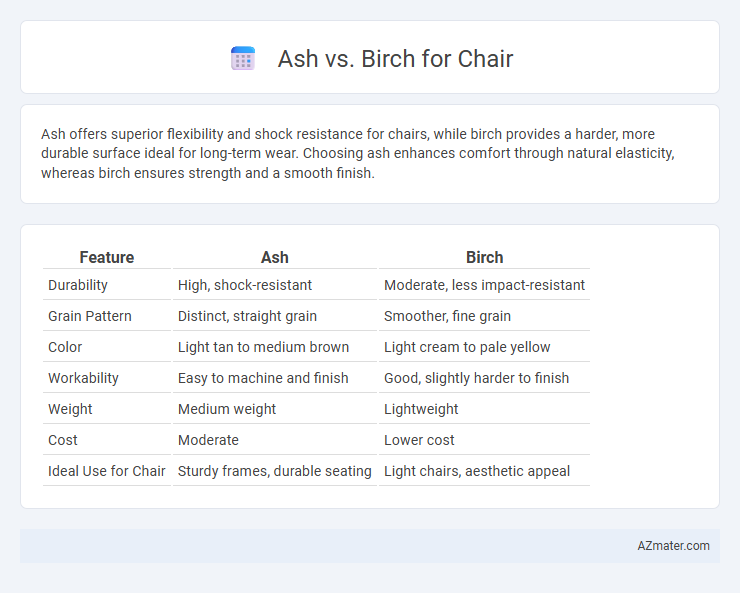Ash offers superior flexibility and shock resistance for chairs, while birch provides a harder, more durable surface ideal for long-term wear. Choosing ash enhances comfort through natural elasticity, whereas birch ensures strength and a smooth finish.
Table of Comparison
| Feature | Ash | Birch |
|---|---|---|
| Durability | High, shock-resistant | Moderate, less impact-resistant |
| Grain Pattern | Distinct, straight grain | Smoother, fine grain |
| Color | Light tan to medium brown | Light cream to pale yellow |
| Workability | Easy to machine and finish | Good, slightly harder to finish |
| Weight | Medium weight | Lightweight |
| Cost | Moderate | Lower cost |
| Ideal Use for Chair | Sturdy frames, durable seating | Light chairs, aesthetic appeal |
Introduction to Ash and Birch Wood
Ash wood, known for its impressive strength and light color grain, is a popular choice for chair manufacturing due to its shock resistance and flexibility. Birch wood, characterized by a fine grain and pale hue, offers durability and a smooth finish that enhances chair aesthetics and comfort. Both woods provide excellent workability and robust performance, making them ideal for crafting sturdy, long-lasting chairs.
Physical Characteristics of Ash vs Birch
Ash wood features a light color with a pronounced straight grain and a coarse texture, offering a strong, flexible structure ideal for chair construction. Birch displays a pale cream to light yellow tone with a fine, even grain and smooth texture, providing moderate hardness and good shock resistance. Both woods are durable, but ash tends to be heavier and more resilient, making it suitable for chairs requiring robust support.
Durability and Strength Comparison
Ash wood offers exceptional durability and strength, making it ideal for sturdy chair construction, as it resists cracking and warping under heavy use. Birch, while also durable, tends to be slightly softer and less shock-resistant than ash, which can affect its longevity in high-traffic seating. The higher Janka hardness rating of ash, typically around 1320, compared to birch's 1260, underscores ash's superior capacity to withstand wear and impact over time.
Workability and Crafting Ease
Ash offers excellent workability due to its straight grain and moderate hardness, making it easy to shape and sand while maintaining durability for chair construction. Birch, known for its fine, even texture and smooth surface, provides superior crafting ease especially for detailed woodworking and intricate designs. Both woods hold screws and glue efficiently, but ash's resilience to shock makes it particularly well-suited for sturdy, everyday use chairs.
Aesthetic Appeal: Grain and Color Differences
Ash wood features a pronounced, straight grain with light tones ranging from creamy white to pale brown, offering a sleek and modern aesthetic for chairs. Birch wood presents a finer, more uniform grain with a subtle pale yellow to light reddish hue, lending chairs a smooth and warm appearance. The distinct grain patterns and color variations between ash and birch significantly influence the visual character and style of furniture pieces.
Comfort and Ergonomics in Chair Design
Ash wood, known for its flexibility and shock resistance, contributes to chair designs that offer superior comfort by adapting to user movements and providing natural support. Birch wood, with its fine grain and firm texture, excels in maintaining structural integrity, ensuring ergonomic stability that supports proper posture during prolonged seating. Chairs crafted from ash often deliver a more dynamic comfort experience, while birch-based chairs emphasize long-lasting ergonomic support and durability.
Cost and Availability of Ash vs Birch
Ash wood typically costs more than birch due to its greater density and durability, making it a premium choice for chair construction. Birch offers a more budget-friendly option with widespread availability, commonly sourced from northern hardwood forests. Both woods are readily accessible in most regions, but birch generally ensures faster delivery times and lower material expenses.
Environmental Impact and Sustainability
Ash wood, harvested from fast-growing, renewable trees, offers a lower environmental impact due to its abundance and shorter growth cycles, making it a sustainable choice for chair production. Birch, while also sustainable, often requires more energy-intensive processing and slower growth rates, which can increase its environmental footprint compared to ash. Both woods are biodegradable and recyclable, but choosing ash supports quicker forest regeneration and reduced carbon emissions in manufacturing.
Best Uses: Which Wood Suits Your Chair?
Ash wood, known for its light color and prominent grain, offers excellent shock resistance and flexibility, making it ideal for chairs that require strong, durable frames like rocking or dining chairs. Birch wood features a fine, even grain and a smooth finish, best suited for chairs needing a polished appearance and moderate hardness, such as office or accent chairs. Choose ash for its resilience and springiness in active seating, while birch excels in applications where aesthetic appeal and a smooth surface are prioritized.
Final Verdict: Choosing Ash or Birch for Your Chair
Ash wood offers exceptional durability and a distinctive grain pattern, making it ideal for chairs requiring strength and aesthetic appeal. Birch provides a smoother finish and cost-effective option, favored for its fine grain and ease of staining. Choosing between ash and birch depends on whether durability and rustic charm outweigh budget considerations and a sleek, uniform look for your chair.

Infographic: Ash vs Birch for Chair
 azmater.com
azmater.com